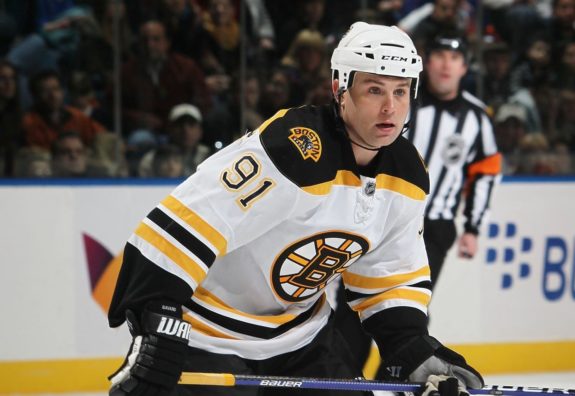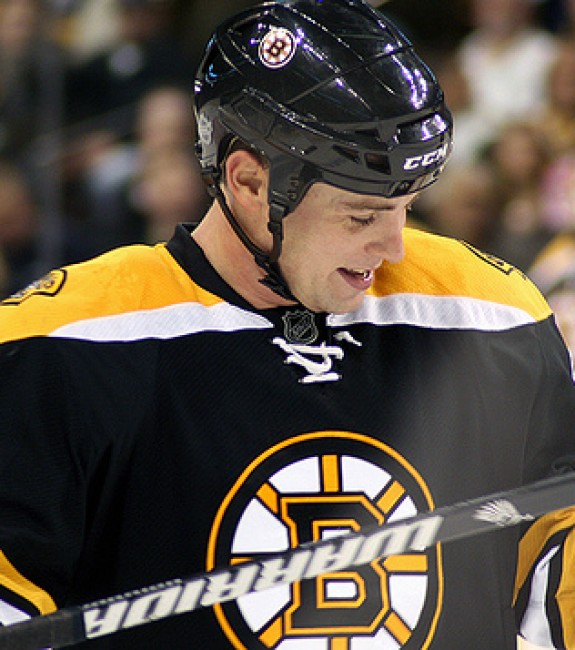The second edition of New York Rangers That Got Away, we’ll be looking at Marc Savard and his brief stint with the organization. You can read my first piece of the series here.
Between their Stanley Cup victory in 1994 and the turn of the century, the New York Rangers struggled to find much talent through the draft. It wasn’t a problem of quantity, but more so the quality of drafts and some bad luck along the way. That being said, a Rangers’ fourth-round selection ended up carving out quite the NHL career, however much of it was spent away from the Big Apple.
Marc Savard was selected 91st overall by the Rangers in the 1995 NHL Entry Draft, infamously known for its lackluster pool and handful of busts. As a model diamond in the rough, Savard should have been a staple on the Rangers during their dark days in the early-2000s.

Yet, one of the most ill-advised trades in organization history delivered Savard to a new franchise while the Rangers were left empty-handed.
The Makings of an Oshawa Legend
Savard began making a name for himself in the prospect community when he went from a 57-point season to a whopping 139-points in 1994-95 for his Oshawa Generals, breaking the franchise single-season scoring record. He led the league in scoring and his 96 assists were second only to Bill Bowler. His 5-foot-10 frame and uncertainty in his ability to repeat such a strong season made him a mid-round selection in the upcoming NHL Entry Draft.
The Rangers were coming off of a lockout-shortened season that saw them get pummeled in the second round of the 1995 NHL Playoffs. Still led by the same faces of the 1994 Stanley Cup run, the Rangers were in the process of contending, rather than looking towards stock in the draft. That being said, when they saw Savard’s name still on the draft board at 91st overall, they pounced on the high-risk, high-reward player. Thankfully, Savard was able to exceed all expectations in the following seasons with the Generals.
As a second-round selection in the 1993 OHL Draft, Savard wasn’t expected to carry the Generals offense as he did, but his unique playmaking ability and quick acceleration made him quite a threat. In his four years with the Generals, the centerman logged 413 points in 238 games, won the scoring title twice, lead the Generals to four straight playoff appearances, and is the franchise in career points. He left such a mark on the club that the team’s seasonal top scorer is the recipient of the Marc Savard Top Scorer award.
Savard’s New York Minute as a Ranger
Following his four dominant years in Oshawa, Savard went onto the professional level where he joined a Rangers roster that was on the tail-end of Stanley Cup contention. In the 1997-98 season, Savard spent most of his season with the Hartford Wolf Pack, scoring a team-leading 74 points in 58 games. He added another 27 points in 15 playoff games, leading the team and finishing third in postseason scoring.

Savard also suited up in a handful of Rangers games, scoring just six points in 28 games while in a limited role. Head coach Colin Campbell was often regarded as a more traditionalist coach that emphasized an increased veteran presence rather than a focus on the younger talents on the team.
Considering the Rangers were struggling with aging stars in Wayne Gretzky, Pat LaFontaine, and Adam Graves, one would expect Campbell to turn to their younger talent to hopefully turn a corner on the season. Unfortunately, Savard would have to wait one more year before finding a more established role with the Rangers.
Savard’s second professional season saw a regular roster spot and increased point production. With Campbell being succeeded by John Muckler, the Rangers were looking towards a new direction, and a 21-year-old Savard seemed to be a young piece of the puzzle. He scored 45 points in 70 games during the 1998-99 season, good for sixth on the team. His 21 even-strength assists and 15 power-play assists were both third on the team.
Related: 10 Coolest Old School NHL Goalie Masks
What’s particularly impressive is that he was able to generate plenty of offense while remaining in a sheltered role. His 14:35 average time-on-ice ranked him dead last amongst the Rangers top-10 scorers of that year. Despite showing plenty of promise in his first full season as a Blueshirt, the front office had seen enough and made one of the most ill-advised trades in Rangers history.
The Trade to Calgary
In the summer of 1999, the Rangers traded Savard and their ninth-overall pick for the Flames’ seventh-overall pick, a third-round pick (that was eventually traded back to the Flames), and the rights to Jan Hlavac. The Rangers then used their selection on Jamie Lundmark, who is infamously one of the organization’s worst first-round selections in the last 25 years.
Hlavac enjoyed two successful seasons with the Rangers, scoring a total of 106 points in 146 games. However, he was eventually flipped to the Philadelphia Flyers as part of the deal that brought Eric Lindros to New York.
Meanwhile, Savard went on to enjoy four more promising seasons with the Calgary Flames before being dealt to the Atlanta Thrashers where he became a point-per-game player. Skating with superstar wingers, Ilya Kovalchuk and Dany Heatley, Savard scored 196 points in 184 games during his three years in Atlanta.
Capitalizing on his established stardom, Savard entered free agency in the summer of 2006 and signed a four-year deal with the Boston Bruins. His 96 points led the team in scoring, and his 74 assists trailed only Sidney Crosby and Joe Thornton that year. In his first three seasons as a Bruin, he scored 262 points in 238 games. Unfortunately, injuries began to plague his career from that point on.
Following injuries to his foot and knee, Savard seemingly was back to full strength during the 2009-10 season. Unfortunately, infamous agitator, Matt Cooke, committed one of the most egregious headshots in NHL history against Savard, giving him a grade 2 concussion and subsequently ending his regular season.
Savard would return two months later to score an unforgettable overtime winner during Game 1 of the 2010 playoffs against the Flyers. He skated in just three playoff games but his goal is still one of the most memorable in Bruins’ recent history.
In the following season, Savard suited up in just 25 games before another concussion ended his season and subsequently his career. He would never play in another NHL game, but still was able to get his name on the Stanley Cup, alongside his 2010-11 Bruins. Despite being cut short by concussions, Savard enjoyed a remarkable 13-year career that all began in with the Rangers at the 1995 NHL Draft. He finished with a total of 706 points in 807 NHL games. There’s an argument to be made that he could have been a Hall of Famer if injuries hadn’t plagued him.
It’s impossible to know for sure, but perhaps the Rangers’ dark days of the post-Stanley Cup era would have been a bit brighter had Savard remained in New York.
